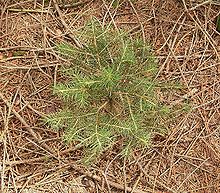- Mast year
-
 Norway spruce (Picea abies) seedlings can establish with greater success during mast years, when seed predators are swamped with food.
Norway spruce (Picea abies) seedlings can establish with greater success during mast years, when seed predators are swamped with food.
A mast year is a year in which vegetation produces a significant abundance of mast (fruit). The term originally applied solely to trees, like oak trees, that produce fruit useful for feeding farm animals. The term "mast" comes from the Old English word "mæst", meaning the nuts of forest trees that have accumulated on the ground, especially those used as food for fattening domestic pigs.[1]
More generally, Masting[2] describes not only abundance, but also paucity of fruit production, so masting is a group phenomenon that results when plants within a population synchronize their reproductive activity both in time and in size of crop.
Masting is the process whereby trees drop a large amount of seeds. This provides food for rats and stoats, whose populations can explode. In turn, this makes it more likely that birds will be targeted by the pests,[3] or that rats will invade nearby fields in what is called a rat flood.[4]
See also
- Mast Seeding
- Predator satiation
- Monocarpy
References
- ^ "mast". Oxford English Dictionary. Oxford University Press. 2nd ed. 1989.
- ^ Kelly, D. 1994. The evolutionary ecology of mast seeding (PDF). Trends Ecol. Evol.. 9(12): 465-470. Accessed on 24 January 2010
- ^ Reich, Josh (Friday, 16 January 2009). "Trappers face pest population explosion". The Nelson Mail. http://www.stuff.co.nz/nelsonmail/4820793a6510.html. Retrieved 2009-02-11.
- ^ Normile D (February 2010). "Holding back a torrent of rats". Science 327 (5967): 806–7. doi:10.1126/science.327.5967.806. PMID 20150483.
Categories:- Fertility
- Agriculture stubs
Wikimedia Foundation. 2010.
